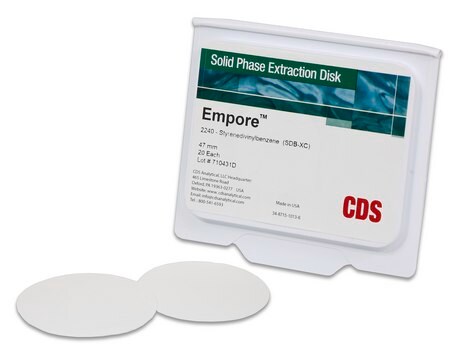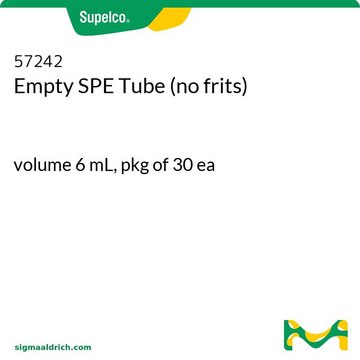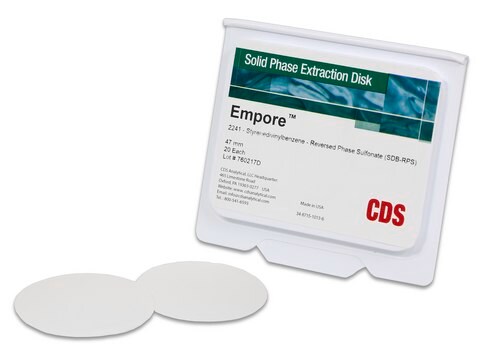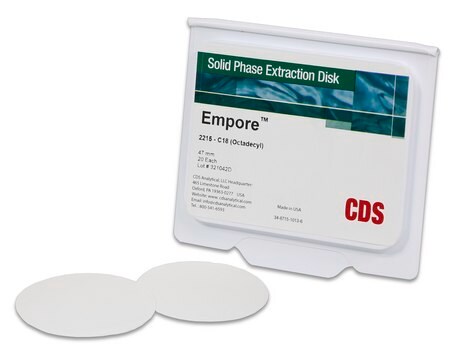66894-U
Empore™ SPE Disks
Chelating resin, diam. 47 mm, pk of 20
Sign Into View Organizational & Contract Pricing
All Photos(1)
About This Item
UNSPSC Code:
13111000
NACRES:
NB.21
Recommended Products
composition
counter-ion (sodium)
packaging
pk of 20
technique(s)
solid phase extraction (SPE): suitable
diam.
47 mm
membrane thickness
0.5 mm
matrix active group
iminodiacetic acid bonding, sodium salt
particle size
10 μm
12 μm
capacity
0.45 capacity (mmol Cu2+)(per 47 mm disk)
Looking for similar products? Visit Product Comparison Guide
General description
Empore membrane SPE technology comprises of SPE particles tightly enmeshed within a network of inert PTFE fibrils (90% SPE particles : 10% PTFE, by weight). The SPE-membrane fabrication process results in a highly dense and uniform extraction medium that offers distinct advantages over traditional sorbent/packed-bed SPE products. Empore SPE technology provides a denser, more uniform extraction bed than traditional packed bed products allowing for smaller bed weights, shorter analyte to pore diffusion paths, and more efficient extractions.
The Empore line of SPE disks comprises of the most complete line of SPE disks for extracting large volumes of aqueous samples. The product line ranges from time-tested C18 to unique phase chemistries such as carbon and the highly polar Oil & Grease disk. The disks are ideal for environmental analysis where 1 L sample volumes are not uncommon and provide an efficient alternative to LLE.
Save Time & Money:
The Empore line of SPE disks comprises of the most complete line of SPE disks for extracting large volumes of aqueous samples. The product line ranges from time-tested C18 to unique phase chemistries such as carbon and the highly polar Oil & Grease disk. The disks are ideal for environmental analysis where 1 L sample volumes are not uncommon and provide an efficient alternative to LLE.
Save Time & Money:
- Reduced SPE Bed Mass = Reduced SPE Solvent & Elution Volumes
- Minimize SPE eluate evaporation time
- Potentially allows for direct injection of the SPE eluate
- Dense & Uniform Extraction Medium = No SPE Channeling and Voiding
- Efficient mass-transfer kinetics allow for faster flow rates
- Eliminate SPE fines improving column and instrument life
Application
Polymer-based cation exchange disk designed for the recovery or removal of multivalent cations (primarily 2+ and 3+ transition metals). The disk functional group exhibits different ionic charges depending on the pH of the solution. At pH 2, the carboxylate groups are neutral and nitrogen has a net positive charge. This allows the resin to function as a weak anion exchanger. Increasing the pH ionizes the carboxylate groups and at pH 5, both are negatively charged. As the pH approaches neutral, the resin functions as a cation exchanger or a chelating resin.
Cation Selectivity:
Cation Selectivity:
- Cu > Cd > Co > Mn > Ba > Ca > Sr
- Zn > Al > Cr > Sn
- Pb > Fe > Ni > Mg
Legal Information
Empore is a trademark of CDS Analytical
Disclaimer
CDS Analytical LLC recently acquired the rights to Empore products from 3M Purification Inc. For an interim phase, you may receive products packaged with either manfacturer′s branding.
Storage Class Code
11 - Combustible Solids
WGK
WGK 3
Flash Point(F)
Not applicable
Flash Point(C)
Not applicable
Choose from one of the most recent versions:
Certificates of Analysis (COA)
Lot/Batch Number
Sorry, we don't have COAs for this product available online at this time.
If you need assistance, please contact Customer Support.
Already Own This Product?
Find documentation for the products that you have recently purchased in the Document Library.
Our team of scientists has experience in all areas of research including Life Science, Material Science, Chemical Synthesis, Chromatography, Analytical and many others.
Contact Technical Service








